If you’re looking into the top premium graphics cards for 2025, I recommend considering options like the MSI RTX 3060, ASUS RTX 5070 Ti, GIGABYTE OC models, and high-end AMD cards like the RX 9060 XT. These combine powerful performance, excellent cooling, and future-proof features like PCIe 5.0 and DLSS 4, all at varying price points. To find the best fit for your gaming rig, I’ll share more details on power, performance, and price to guide your choice.
Key Takeaways
- Top-tier gaming GPUs in 2025 offer high performance with architectures like NVIDIA Blackwell and Ampere, supporting 4K and high-refresh-rate gaming.
- Premium cards feature advanced cooling solutions such as vapor chambers and triple-fan setups for optimal thermal management.
- Connectivity options include HDMI 2.1, DisplayPort 2.1, and PCIe 5.0, ensuring compatibility with the latest monitors and systems.
- Build quality and durability are emphasized with military-grade components, RGB aesthetics, and robust construction for long-lasting use.
- Power requirements and physical sizes vary, with high-end models needing 550W+ PSUs and ample case space for seamless integration.
MSI GeForce RTX 3060 12GB Graphics Card

If you’re building a gaming rig in 2025 and want a reliable yet powerful graphics card, the MSI GeForce RTX 3060 12GB is an excellent choice. It features the Ampere architecture, with a core clock speed of 1710 MHz and 12GB of GDDR6 memory running at 1807 MHz. This card supports PCIe 4.0, ensuring fast data transfer, and offers multiple display outputs, including three DisplayPorts and an HDMI 2.1, supporting up to 7680 x 4320 resolution. Its cooling system, equipped with Torx Twin Fans, keeps temperatures in check, and the OC model boosts performance further for demanding games.
Best For: gamers and content creators seeking a reliable, high-performance graphics card for 4K gaming and demanding applications in 2025.
Pros:
- Supports high-resolution displays up to 7680 x 4320 for immersive visuals
- Equipped with cooling Torx Twin Fans to maintain optimal temperatures during intensive use
- Features overclocked OC model for enhanced gaming performance
Cons:
- Limited to three DisplayPorts, which may require adapters for multiple monitors
- No mention of ray tracing or DLSS capabilities in the provided specs
- As an older generation card, it may face limitations with the newest AAA titles at ultra settings
ASUS TUF Gaming GeForce RTX 5070 Ti 16GB Graphics Card

Looking for a high-performance graphics card that can handle the most demanding games in 2025? The ASUS TUF Gaming GeForce RTX 5070 Ti 16GB is a powerhouse. It features NVIDIA’s Blackwell architecture, PCIe 5.0 support, and HDMI 2.1, ensuring fast data transfer and high-quality visuals. The 3.125-slot design with a massive fin array and axial-tech fans delivers excellent airflow and cooling. OC mode boosts the clock to 2610 MHz, and the phase-change thermal pad keeps temperatures low under heavy loads. Built with military-grade components and protective coatings, it’s reliable and durable, perfect for long gaming sessions and overclocking.
Best For: gamers and power users seeking top-tier graphics performance for demanding titles and overclocking in 2025.
Pros:
- Exceptional performance with NVIDIA Blackwell architecture and high clock speeds in OC mode
- Advanced cooling solution with axial-tech fans and phase-change thermal pad for low temperatures and enhanced longevity
- Robust build with military-grade components and protective coatings for durability and reliability
Cons:
- Large 3.125-slot design may require spacious cases and careful installation
- Higher power consumption due to high-performance features and advanced architecture
- Premium price point reflecting its high-end features and build quality
GIGABYTE GeForce RTX 3060 Gaming OC 12G Graphics Card
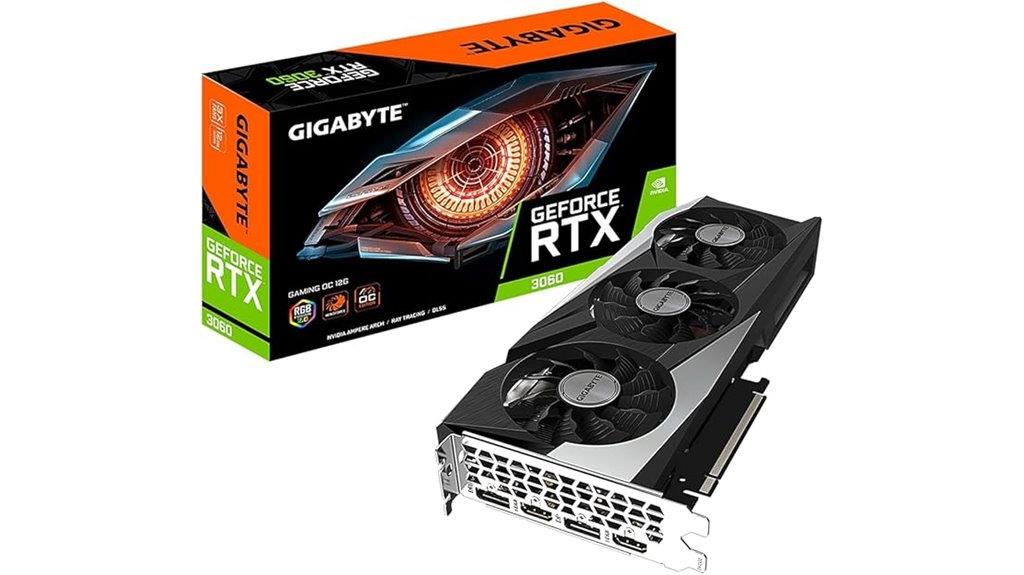
The GIGABYTE GeForce RTX 3060 Gaming OC 12G stands out as an excellent choice for gamers seeking high performance at a reasonable price. Powered by NVIDIA’s Ampere architecture, it offers advanced RT and Tensor Cores for real-time ray tracing and AI tasks. With a core clock of 1837 MHz and 12GB of GDDR6 memory, it handles demanding games and creative workloads smoothly. The WINDFORCE 3X cooling system keeps temperatures in check, while RGB Fusion 2.0 adds aesthetic appeal. Its versatile connectivity options, including dual HDMI 2.1 and DisplayPort 1.4, make it compatible with various setups. Overall, it’s a solid, mid-range GPU with impressive features.
Best For: gamers and creative professionals seeking high performance, real-time ray tracing, and AI acceleration at a reasonable price point.
Pros:
- Powerful NVIDIA Ampere architecture with advanced RT and Tensor Cores for stunning visuals and AI tasks
- 12GB GDDR6 memory with high bandwidth for demanding games and creative workloads
- Effective WINDFORCE 3X cooling system and aesthetic RGB lighting for optimal performance and style
Cons:
- Slightly bulky size may require careful case compatibility
- Limited to a maximum resolution of 7680×4320, which may not cover extremely high-end multi-monitor setups
- Some features like RGB lighting and cooling may add to the overall noise and power consumption
ASUS TUF Gaming GeForce RTX 5080 16GB Graphics Card

The ASUS TUF Gaming GeForce RTX 5080 16GB Graphics Card stands out for gamers seeking top-tier performance and durability. Built on NVIDIA’s Blackwell architecture, it delivers exceptional gaming and professional workload capabilities. With DLSS 4 technology, axial-tech fans, and a vapor chamber, it maintains excellent thermal performance even under heavy loads. Its military-grade components and protective PCB coating ensure long-lasting reliability against dust, moisture, and debris. The 3.6-slot design with a large fin array maximizes airflow and cooling efficiency. Factory overclocked, it offers extra performance right out of the box, making it a solid choice for high-end gaming rigs in 2025.
Best For: gamers and professionals seeking high-performance, durable graphics with advanced thermal management and overclocking capabilities for demanding workloads in 2025.
Pros:
- Exceptional performance with NVIDIA Blackwell architecture and factory overclocking
- Superior thermal management thanks to vapor chamber, axial-tech fans, and phase-change thermal pad
- Built with military-grade components and protective PCB coating for enhanced durability and longevity
Cons:
- Large 3.6-slot design may require significant space in smaller cases
- Premium features and build quality come at a higher price point
- Compatibility with older systems may require BIOS updates or additional power considerations
XFX Radeon RX 580 GTS XXX Edition Graphics Card (RX-580P8DFD6)
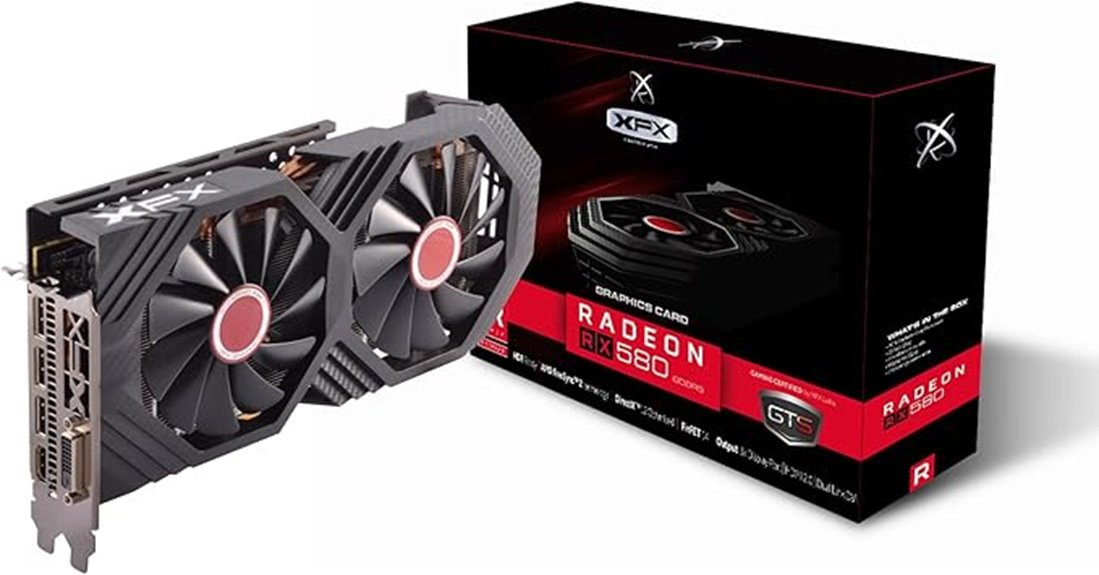
If you’re building a gaming rig that demands both high performance and immersive visuals, the XFX Radeon RX 580 GTS XXX Edition is an excellent choice. It features a boosted clock of 1386MHz, backed by 8GB of GDDR5 memory running at 8.0GHz, ensuring smooth gameplay and sharp visuals. Built on Polaris architecture with 14nm FinFET technology, it offers efficiency and power. The dual BIOS and XFX double dissipation cooling keep temperatures in check during intense gaming sessions. With VR readiness and multiple display options—including DisplayPort, HDMI, and DVI—it’s designed for immersive experiences. This card balances performance and affordability for serious gamers in 2025.
Best For: gamers and virtual reality enthusiasts seeking high performance, immersive visuals, and reliable cooling in their gaming setup.
Pros:
- Factory overclocked for enhanced gaming performance with a boost clock of 1386MHz
- 8GB GDDR5 memory ensures smooth visuals and multitasking capabilities
- Dual BIOS and double dissipation cooling technology for optimal thermal management
Cons:
- Minimum power requirement of 500 watts may require a higher wattage power supply
- Limited to 4th gen GCN architecture, which might be less future-proof compared to newer models
- Only supports up to three displays, which may be limiting for multi-monitor setups
ASUS TUF Gaming GeForce RTX 5070 Ti 16GB Graphics Card
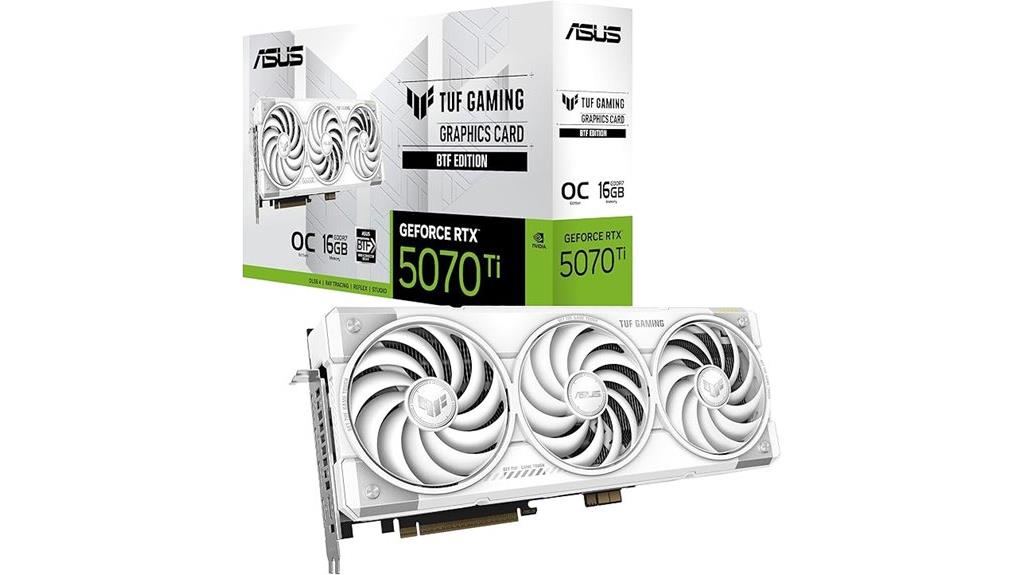
For gamers seeking top-tier performance and durability, the ASUS TUF Gaming GeForce RTX 5070 Ti 16GB stands out with its cutting-edge NVIDIA Blackwell architecture and DLSS 4 technology. It features a PCIe® 5.0 interface, HDMI®/DP 2.1 outputs, and a 3.125-slot design with a massive fin array for ideal airflow. With OC mode boosting to 2610 MHz and AI performance of 1484 TOPS, it delivers impressive speed. Built with military-grade components, thermal pads, and a protective PCB coating, it’s designed for longevity and reliability. The auto-Extreme manufacturing process, coupled with ASUS’s GPU Guard, ensures that this card remains durable under intense gaming sessions.
Best For: gamers and PC enthusiasts seeking high-performance, durable graphics with cutting-edge NVIDIA architecture and advanced cooling features.
Pros:
- Exceptional performance with OC mode boosting to 2610 MHz and 1484 AI TOPS AI performance
- Robust build quality featuring military-grade components, thermal pads, and protective coatings for durability
- Advanced thermal management with axial-tech fans and a massive fin array for optimal airflow
Cons:
- Large 3.125-slot design may require a spacious PC case for installation
- Premium features and components can result in a higher price point
- Power requirements with the GC-HPWR adapter may necessitate a compatible high-capacity power supply
RX 580 Graphics Card 8GB for Gaming PC
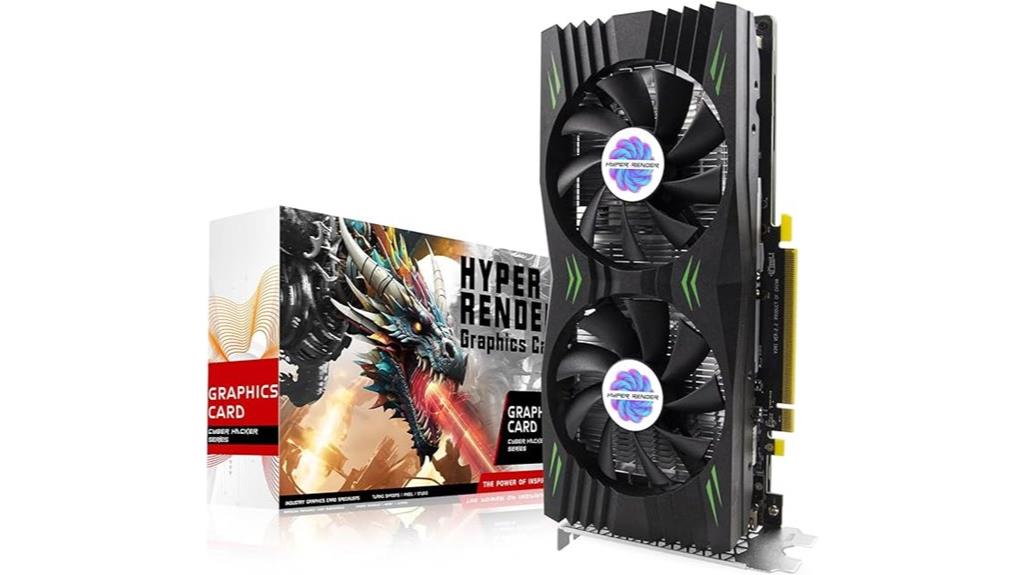
Looking for a powerful yet affordable GPU that can handle the latest games without breaking the bank? The RX 580 8GB offers excellent performance with its 14nm architecture, 2048 stream processors, and 8GB GDDR5 memory. It delivers smooth gameplay on demanding titles and vivid visuals with enhanced contrast and colors. The card supports up to two displays, making multitasking easy, and features a smart cooling system with dual fans for quiet operation and longevity. Its durable design and thermal management guarantee reliable performance during intense gaming sessions. With a solid rating and competitive price, the RX 580 remains a popular choice for budget-conscious gamers.
Best For: budget-conscious gamers seeking reliable performance for the latest titles with smooth visuals and multitasking capabilities.
Pros:
- Excellent performance on demanding games thanks to 14nm architecture and 8GB GDDR5 memory
- Supports multi-monitor setups, ideal for multitasking and immersive gaming experiences
- Quiet operation with smart fan control and durable construction enhances longevity
Cons:
- Slightly older technology compared to newer GPU models
- Limited to two display outputs, which may restrict more extensive multi-monitor configurations
- Might require additional power supply considerations for optimal performance
QTHREE GeForce GT 730 4GB Low Profile Graphics Card

The QTHREE GeForce GT 730 4GB Low Profile Graphics Card stands out as an ideal choice for budget-conscious users who need reliable multimedia performance in compact systems. It features an NVIDIA GT 730 GPU, 4GB DDR3 memory, support for DirectX 12, and a 1000 MHz memory clock, making it suitable for HD video playback and light tasks. Its low-profile design fits small cases and multi-monitor setups with up to four displays. Consuming just 30W and requiring no external power, it’s easy to install and compatible with Windows 11. Perfect for upgrading older PCs or building space-efficient rigs without breaking the bank.
Best For: budget-conscious users seeking reliable multimedia performance in compact systems and multi-monitor setups.
Pros:
- Low power consumption (30W) with no external power needed
- Supports multiple outputs (up to 4 monitors) and HD video playback
- Easy to install with plug-and-play compatibility, suitable for small form factor builds
Cons:
- Limited to basic tasks; not suitable for gaming or high-performance applications
- DDR3 memory may be less efficient compared to newer DDR4/DDR5 options
- Requires PCI Express 2.0 x8 slot, which may be less common in newer systems
GIGABYTE 2GB RAM DDR3 SDRAM Video Graphics Cards GV-N710D3-2GL REV2.0
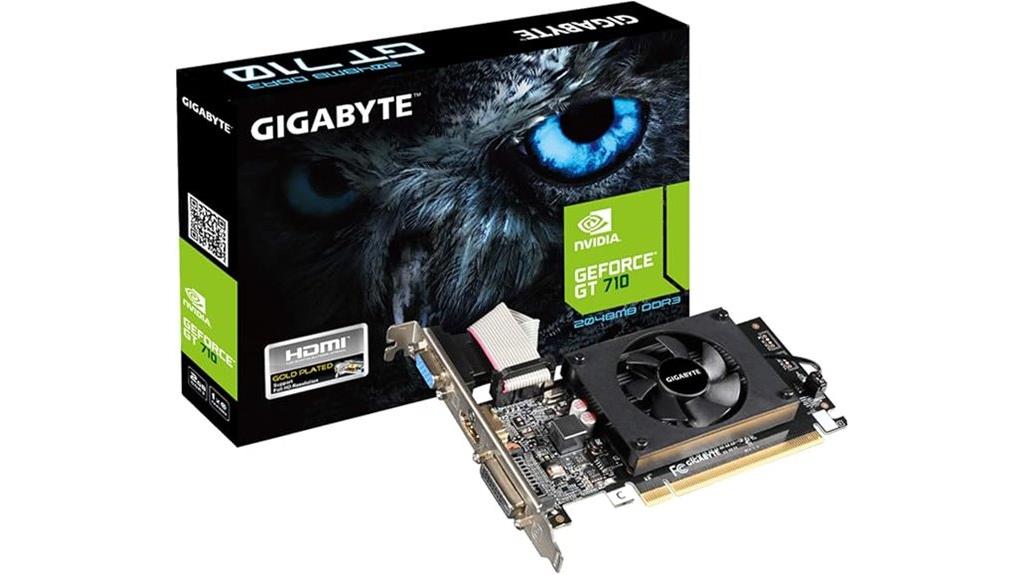
If you’re building a compact or budget-friendly rig that still needs reliable graphics capabilities, the GIGABYTE GV-N710D3-2GL REV2.0 stands out. It features an NVIDIA GeForce GT 710 chipset with 2GB DDR3 SDRAM, making it suitable for basic gaming, multimedia, and office tasks. Its low-profile design fits well in small cases, and it supports a maximum resolution of 4096×2160 pixels. With multiple video outputs—DVI-D, D-Sub, and HDMI—it offers flexible connectivity. Despite its age, it’s rated highly by users and provides a dependable, affordable option for those who need decent graphics without breaking the bank.
Best For: budget-conscious users building compact desktops who need reliable basic graphics for office work, multimedia, and light gaming.
Pros:
- Compact, low-profile design suitable for small form factor cases
- Supports high-resolution displays up to 4096×2160 pixels
- Multiple connectivity options including DVI-D, D-Sub, and HDMI
Cons:
- Limited performance for high-end gaming or intensive graphics applications
- DDR3 memory is outdated compared to newer standards
- No support for unofficial software, which may restrict customization options
PNY NVIDIA GeForce RTX™ 5050 Graphics Card (8GB GDDR6)

For gamers and creative professionals seeking a compact yet powerful graphics card, the PNY NVIDIA GeForce RTX™ 5050 stands out thanks to its SFF-ready 2-slot design and PCIe® 5.0 compatibility. Equipped with 8GB of GDDR6 memory, it delivers solid performance for gaming and creative tasks. Built on NVIDIA’s Blackwell Architecture, it features DLSS 4 technology, AI-enhanced rendering, and advanced cores for faster responsiveness and improved image quality. Its dual fan setup ensures efficient cooling, while HDMI and DisplayPort 2.1 outputs support multiple high-resolution displays. This card offers a great balance of power, efficiency, and size, making it ideal for versatile, high-performance setups.
Best For: gamers and creative professionals seeking a compact, high-performance graphics card with advanced AI features and versatile connectivity.
Pros:
- Compact 2-slot design suitable for small form factor builds
- PCIe 5.0 support ensures future-proof bandwidth and performance
- Built-in DLSS 4 and AI-enhanced rendering for improved visuals and efficiency
Cons:
- Limited 8GB GDDR6 memory may be less optimal for extremely demanding workloads
- Dual fan setup might be less effective in very high thermal environments
- May require a compatible high-power supply due to PCIe 5.0 compatibility
PowerColor Hellhound Spectral White AMD Radeon RX 9060 XT 16GB GDDR6 Graphics Card

Designed for serious gamers and content creators, the PowerColor Hellhound Spectral White AMD Radeon RX 9060 XT stands out with its impressive 16GB GDDR6 memory and 20 GHz graphics processor, delivering smooth performance even in demanding applications. It supports ultra-high resolutions up to 7680×4320, perfect for immersive gaming and professional tasks like 4K video editing. The sleek spectral white design adds a modern aesthetic, while its compact dimensions ensure compatibility with various builds. Equipped with HDMI 2.1b and DisplayPort 2.1a, it offers versatile connectivity. With a robust 550W power requirement and a solid user rating of 4.4 stars, this card balances power, performance, and style.
Best For: gamers and professional content creators seeking high-resolution graphics and demanding performance in their builds.
Pros:
- 16GB GDDR6 memory offers excellent performance for gaming and professional tasks
- Supports ultra-high resolutions up to 7680×4320 for immersive visuals
- Modern spectral white design enhances aesthetic appeal and matches contemporary PC builds
Cons:
- Requires a minimum of 550W power supply, which may necessitate system upgrades
- Internal length of 310mm may limit compatibility with smaller cases
- Relatively high weight (1.78 pounds) could impact installation in certain setups
GIGABYTE GeForce RTX 5050 Gaming OC 8G Graphics Card

The GIGABYTE GeForce RTX 5050 Gaming OC 8G stands out as an excellent choice for gamers seeking cutting-edge performance in 2025. Built on NVIDIA’s Blackwell architecture, it supports PCIe 5.0, ensuring future-proof connectivity. With 8GB of GDDR6 memory and a 128-bit interface, it delivers smooth, high-quality visuals. The WINDFORCE cooling system, featuring Hawk fans and thermal conductive gel, keeps temperatures in check during intense gaming sessions. Plus, DLSS 4 support boosts frame rates and image quality. Overall, this card combines power, advanced thermal management, and efficiency, making it a standout option for high-performance gaming rigs this year.
Best For: gamers and high-performance graphics enthusiasts seeking cutting-edge visuals and future-proof connectivity for 2025 gaming and graphics processing.
Pros:
- Supports PCIe 5.0 for faster data transfer and future compatibility
- Equipped with 8GB GDDR6 memory for smooth, high-quality visuals
- Advanced WINDFORCE cooling system ensures efficient thermal management during intense gaming sessions
Cons:
- May be priced higher due to premium features and architecture
- Limited to 8GB memory, which might be restrictive for some extreme workloads
- Compatibility depends on supporting PCIe 5.0 slots and power requirements
Factors to Consider When Choosing Premium Graphics Cards for Gaming Rigs

When selecting a premium graphics card, I consider its performance capabilities to guarantee it handles the latest games smoothly. I also check cooling efficiency and compatibility to keep everything running cool and fit perfectly in my case. Finally, I pay attention to power consumption and physical size to match my setup’s requirements and avoid surprises.
Performance Capabilities
To choose a premium graphics card that truly elevates your gaming experience, understanding its performance capabilities is crucial. Higher core clock speeds, like over 1700 MHz, translate to better frame rates and smoother gameplay. Advanced architectures such as Ampere and Blackwell substantially enhance real-time ray tracing and AI-driven features, boosting visual fidelity. Larger video memory—12GB or 16GB GDDR6 or GDDR7—ensures smooth performance at high resolutions and with demanding textures. Support for high-bandwidth interfaces like PCIe 4.0 or 5.0 allows faster data transfer, minimizing bottlenecks. Additionally, robust cooling solutions and build quality are essential for maintaining stable performance during extended gaming sessions. These factors collectively define a graphics card’s ability to deliver power, speed, and consistent performance.
Cooling Efficiency
Choosing a premium graphics card hinges not only on raw performance but also on its cooling efficiency, which directly impacts stability and longevity. Effective cooling solutions like axial-tech fans and vapor chambers keep temperatures in check during intense gaming. High-performance thermal pads and heatsinks improve heat dissipation, preventing thermal throttling and ensuring consistent performance. Multiple fan configurations, such as triple or quad setups, boost airflow and reduce hot spots within the GPU. These robust cooling systems are especially essential for overclocked models, allowing higher clock speeds without overheating. Advanced thermal management features—like phase-change thermal pads and coated PCBs—further extend component lifespan and enhance overall thermal efficiency. A well-cooled GPU ensures your rig runs smoothly and reliably, even during prolonged gaming sessions.
Compatibility Requirements
Selecting a premium graphics card requires careful attention to compatibility factors to guarantee it integrates seamlessly with your existing setup. First, check that your motherboard supports the PCIe interface version (such as PCIe 4.0 or 5.0) that your new card requires. Next, ensure your power supply can deliver enough wattage and has the correct connectors—whether 8-pin, 6-pin, or the newer GC-HPWR—needed by the card. You also need to verify that your case provides enough space for the card’s dimensions, including length, width, and slot height. Additionally, confirm your motherboard has the necessary display outputs, like HDMI 2.1 or DisplayPort 2.1, to match your monitor setup. Finally, make sure the card supports your display’s resolution and refresh rate for peak gaming performance.
Power Consumption
High-end graphics cards demand more power, which means you’ll need a robust power supply to maintain stability and performance. Power consumption varies widely, from around 150W for entry-level models to over 350W for top-tier GPUs. Premium cards often use multiple power connectors, like 8-pin or 6-pin PCIe cables, to handle overclocking and sustained high loads. Managing this power draw is vital to prevent system instability. Efficient thermal design and cooling solutions are essential because higher power usage generates more heat, which can cause thermal throttling if not properly managed. Monitoring power consumption through software tools helps optimize performance, especially when overclocking or running demanding games. Choosing a GPU with appropriate power needs ensures both stability and longevity for your gaming rig.
Physical Dimensions
Understanding the physical dimensions of a graphics card is essential because it directly affects compatibility with your PC case and airflow. Length, width, and height determine whether the card will fit comfortably inside your build. Larger, multi-slot cards with extensive fin arrays need more space and can block other components or limit airflow, impacting cooling. Conversely, compact or low-profile cards suit small form factor cases but may have restricted cooling capabilities and performance potential. Precise measurements, including slot thickness (like 2.0, 2.5, or 3.125 slots), ensure proper installation without obstructing adjacent components. Additionally, the overall size and weight influence mounting stability, especially for heavier, high-end models, which might require extra support or reinforcement to prevent sagging or damage.
Advanced Features
When choosing a premium graphics card, the array of advanced features can considerably influence your gaming experience. Modern cards incorporate cutting-edge architectures like NVIDIA Blackwell or AMD Radeon RX 9060 XT, boosting performance and efficiency. Features such as DLSS 4, AI TOPS, and real-time ray tracing notably enhance visual fidelity and responsiveness, making games look stunning and feel smooth. Overclocking capabilities, including factory overclocked modes like OC or BTF editions, offer extra performance headroom for demanding titles. Enhanced thermal management technologies—like phase-change thermal pads and vapor chambers—ensure stable operation during intense gaming sessions. Additionally, support for connectivity standards like PCIe 5.0, HDMI 2.1, and DisplayPort 2.1 provides high-resolution multi-monitor setups and future-proofing, making these cards an excellent investment for serious gamers.
Build Durability
Building a durable graphics card is essential for guaranteeing it can handle the rigors of intense gaming sessions without faltering. Premium cards incorporate military-grade components and reinforced PCBs, making them resistant to prolonged heavy loads and thermal stress. High-quality thermal management materials like phase-change thermal pads and vapor chambers help extend the GPU’s lifespan under demanding conditions. Robust cooling solutions, including axial-tech fans and multi-fan setups, prevent overheating and keep performance stable. Protective coatings on the PCB shield against moisture, dust, and debris, reducing the risk of short circuits and physical damage. Additionally, reinforced mounting brackets and sturdy metal backplates ensure the card stays securely in place during intense gaming or transportation. All these features contribute to a long-lasting, reliable gaming rig.
Brand Reliability
Choosing a reliable graphics card starts with selecting a reputable brand known for quality manufacturing. Established brands with a proven track record tend to produce more durable and dependable cards, reducing the risk of hardware failures. They often provide better customer support, warranty services, and firmware updates, which help maintain peak performance over time. Reliable brands also follow strict quality control standards, minimizing defects and ensuring consistency. Positive user reviews and industry awards further reinforce a brand’s reputation for reliability. Additionally, choosing trusted brands can help avoid compatibility issues and ensure access to genuine parts and accessories. Overall, prioritizing brand reputation helps you invest in a graphics card that offers long-term performance, peace of mind, and value for your gaming rig.
Frequently Asked Questions
How Do Different Ray Tracing Capabilities Affect Gaming Performance?
Different ray tracing capabilities can considerably impact gaming performance. When a graphics card has advanced ray tracing features, it creates more realistic lighting and shadows, but this often demands more GPU power, leading to lower frame rates. I’ve noticed that enabling ray tracing enhances visual quality, yet it can strain performance on less powerful cards, so balancing settings for smooth gameplay is key.
What Is the Impact of VRAM Size on Future Game Compatibility?
Imagine a sprawling universe, full of intricate details waiting to come alive. That’s what VRAM size does for future games—it’s like the storage space for your universe. The bigger the VRAM, the more textures, shadows, and high-res assets your card can handle without stuttering. As games get richer and more demanding, having ample VRAM guarantees your rig remains compatible and smooth, even in the most visually stunning worlds.
How Do Cooling Solutions Influence Graphics Card Lifespan?
Cooling solutions play a vital role in extending my graphics card’s lifespan. When I use effective cooling, it keeps the GPU temperature low, preventing overheating and thermal damage. I prefer high-quality fans, liquid cooling, or good airflow setups because they help maintain ideal performance over time. Proper cooling also reduces noise and guarantees my card runs efficiently for years, which ultimately protects my investment and gaming experience.
Are Factory Overclocked Cards Worth the Extra Cost?
I believe factory overclocked cards are worth the extra cost because they offer immediate performance boosts without DIY hassle. For instance, I upgraded to a factory overclocked GPU last year, and it ran cooler and faster right out of the box, enhancing my gaming experience. If you want top-tier performance without tinkering, paying that premium can be a smart investment in longevity and smooth gameplay.
How Does Power Consumption Vary Among High-End GPUS?
Power consumption varies quite a bit among high-end GPUs. Some models draw more power due to higher clock speeds and increased core counts, while others are more efficient thanks to advanced manufacturing processes. I’ve found that choosing a GPU with optimized power efficiency helps reduce energy costs and heat output, making it a smarter choice for long-term use. Always check the TDP ratings to get a clear picture of power demands.
Conclusion
So, whether you’re eyeing the latest RTX 5080 or considering a reliable GTX model, the perfect card is out there. But which one will elevate your gaming to new heights? The choice isn’t just about power—it’s about finding that sweet spot between performance, price, and future-proofing. Stay tuned, because in 2025, the next game-changing GPU might just be around the corner, waiting to redefine your gaming experience entirely.









